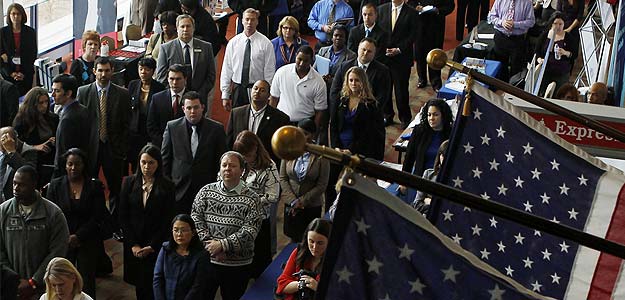
Washington: The number of Americans filing for unemployment benefits unexpectedly rose last week, but the underlying trend continued to point to a strengthening labor market.
The labor market’s resilience was reinforced by another report on Thursday showing announced layoffs by US companies tumbled 18 per cent in February. The signs of sustained labor market strength were the latest indication the economy is regaining momentum after slowing in the fourth quarter.
“Through some of the ups and downs in the weekly series, it looks like the trend in initial claims has improved over the past month, signaling that the labor market continues to improve despite weakness in several other recent economic reports,” said Daniel Silver, an economist at JPMorgan in New York.
Initial claims for state unemployment benefits increased 6,000 to a seasonally adjusted 278,000 for the week ended February.27, the Labor Department said. Economists had forecast claims slipping to 271,000 in the latest week.
Claims have now been below the 300,000 threshold, which is associated with healthy labor market conditions, for a year. That is the longest period since the early 1970s.
The four-week moving average of claims, considered a better measure of labor market trends as it irons out week-to-week volatility, fell 1,750 to 270,250 last week, the lowest level since late November.
In a separate report, global outplacement consultancy Challenger, Gray & Christmas Inc said US-based companies announced 61,599 job cuts last month, down from 75,114 in January. It said layoffs remained concentrated in the troubled energy sector, which has been hit by a slump in crude oil prices, where employers announced 25,051 job cuts in February.
But the firmer labor market picture was dimmed by a third report showing employment in the vast services sector contracting in February for the first time in two years.
The Institute for Supply Management said its index of services industries employment fell 2.4 percentage points to a reading of 49.7 percent. That contributed to the ISM’s nonmanufacturing index dipping 0.1 percentage point to a reading of 53.4 last month.
The dollar was trading lower against a basket of currencies and US stocks fell, also reflecting weaker oil prices. Prices for US government debt fell marginally.
STRONG PAYROLLS EXPECTED
While the claims data has no bearing on Friday’s employment report for February as it falls outside the survey period, it was the latest indication that the labor market remains on solid footing despite a recent tightening in financial market conditions sparked by worries of a recession.
A report on Wednesday showed strong private sector hiring last month, suggesting a pick-up in overall job growth.
According to a Reuters survey of economists, nonfarm payrolls likely increased by 190,000 jobs last month after rising 151,000 in January. The unemployment rate is seen steady at an eight-year low of 4.9 percent.
The encouraging labor market data joins reports on manufacturing and consumer spending in suggesting economic growth picked up at the start of the year after slowing to an annual rate of 1.0 per cent in the fourth quarter.
In a fourth report, the Commerce Department said new orders for manufactured goods rebounded 1.6 per cent after dropping 2.9 per cent in December. That was the largest increase since June and followed two straight months of declines.
The increase in factory orders was the latest suggestion that the worst of the factory slump was likely over.
Factory activity, which accounts for about 12 per cent of the economy, has been slammed by a strong dollar and weak global demand, which have undercut exports. Spending cuts by energy firms in the wake of a plunge in oil prices are also a drag, as are efforts by businesses to reduce an inventory glut.
The signs of a pick-up in economic growth, together with steadily rising inflation and improving financial market conditions could keep interest rate increases from the Federal Reserve this year on the table.
The US central bank is not expected to raise its overnight benchmark interest rate at the March 15-16 meeting. The Fed hiked rates in December for the first time in nearly a decade.
In another report, the Labor Department said non-farm productivity fell at a 2.2 percent rate in the fourth quarter and not the 3.0 percent pace it reported last month. Still, labor-related costs increased solidly as companies employed more workers to raise output.
While weak productivity has boosted employment growth as companies hire more workers to increase output, sustained weakness could undermine Americans’ living standards. Soft productivity has significantly lowered the economy’s long-run potential.
Growth in unit labor costs, the price of labor per single unit of output, was revised down to a 3.3 percent rate from a 4.5 percent pace.
[“source-ndtv”]